Is your dog afraid of fireworks? How about thunder?
Keep reading, this blog post contains everything you need to know. This post is updated and all the links are double-checked about twice a year, last on June 12th, 2025 – look for the “revised” signs in the post to find the latest changes.
Is your dog not fearful of fireworks, thunder or other loud noise?
Keep reading anyway. That may change, and you should be prepared.
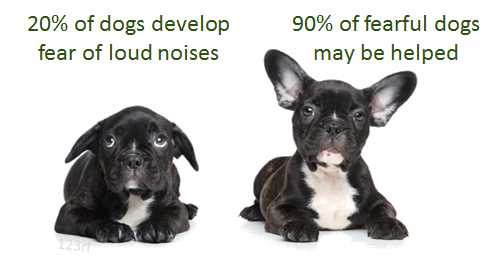
Fear of fireworks and thunder often lead to similar reactions in dogs, ranging from milder symptoms like cowering, pacing or whining, to house soiling, tearing up the furniture, and even vomiting.
Noise phobia could potentially have very serious consequences – more pets go missing around the fourth of July than any other time of the year.
Not all find their way home again. Only 14%.
In this blog post, you’ll learn:
- 1) how to help your anxious dog on the same day of the fireworks or thunderstorm,
- 2) how to prepare your poor pooch when there’s more time,
- 3) how to prevent your puppy from developing fear of noise, and
- 4) how to recognize the early signs of anxiety.
This is a long blog post.
A very long blog post. Over 6200 words, actually.
It’s also a blog post that I think many people will return to several times. And so I made it available as an e-book that you could download and save as a reference. You’ll also get a copy of the infographic poster above!
Here’s a three minute video explaining the framework of this blog post.
If you’re daunted by the thought of a looooong written blog post, you can also get access to it through a 2-hour long paid webinar that I did together with Grisha Stewart, discussing this information in detail, including lots of visual material and videos of animals being trained. Find it here.
And below you’ll find the 50-minute free version, where I discuss the major ideas in this blog post with Dr Holly Tett from Pawsup Dogs, as part of her excellent KIENO conference.

Are the dreaded fireworks expected for tonight, or dark clouds at the horizon foreboding a thunder storm? There may not be time to get a vet appointment, but a visit to the pharmacy or grocery store may be doable if you have some time.
Don’t panic.
Part 1 – fireworks/thunder today
What to do if there’s no time
There are a large number of things you can do on the day of the fireworks / thunderstorm to make things easier on your dog.
Is it starting now, as you’re reading this? OK, here is what you need to do now, with absolutely no time to spare:
Arrange the environment:
Don’t confine the animal, but provide free access to a favourite hiding place. This is probably the single most important thing you can do at this time. Allowing the animal to hide is allowing him to cope. Think of this location as the animal’s Safe Haven. He shouldn’t be confined, but have freedom of movement.
Reduce the amount of incoming stimuli (aversive noise / light / smell) by padding the hideout with pillows or cloth.
This should be a calm, cozy, inviting place. If light flashes are coming through the door frame, the hideout room shouldn’t be dark but brightly lit instead. If there’s no hideout place available, at least pull the curtains and turn the lights on.
High-pitched sounds are often directional and absorbed by large objects, so it’s easy to pinpoint where they’re coming from, and they can relatively easily be avoided by simply hiding in the right spot. Low frequency sounds, on the other hand, are non-directional and tend to pass through solid objects. This makes it hard to determine where the sound is coming from, and since the animal can’t cope with the noise by moving away (because it passes through solid objects), these low-frequency sounds are typically more stressful. So, if you’re trying to reduce the incoming noise of a thunder storm, padding with pillows probably won’t absorb the low frequency sounds. Going into a basement might be a better choice to filter out those low-pitched sounds.
Stick your head inside the shelter and knock on the wall. If the sound is muffled, it should be OK, but if there’s any resonance it may actually make things worse – again, make sure you don’t confine the animal but he can choose to use the shelter – or not.
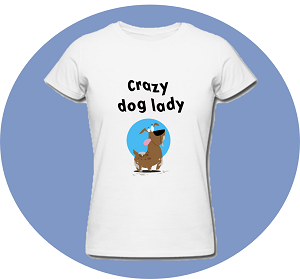
Consider adding some clothing that the animal’s favourite person has worn to provide some added smelly comfort. Ideally, stay with the animal (more on what to do below).
The presence of non-fearful, familiar, friendly dogs may also buffer stress.
Calming Caps reduce the amount of visual information, which may also be calming (although they are most commonly used to reduce arousal during car rides).
Mask incoming sound by running electrical appliances such as a washing machine, or playing music. Through a Dog’s Ear have prepared CDs that have shown to relax dogs even better than ordinary classical music (Leeds & Wagner 2009).
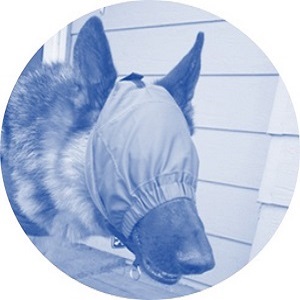
Eileen Andersson discusses other ideas to masking sound (ideally containing low frequencies) in this blog post. Indeed, she suggests that it’s the best way to protect dogs from unwanted sounds.
Mutt muffs are ear covers for dogs that reduce incoming noise – they are commonly used during noisy airplane rides.
Your dog shouldn’t be worried by the arrangements per se. For instance, if he’s never worn mutt muffs, that might not be a good idea. These ideas are all meant to calm the animal, not make things worse.
Ford (yes, the car company) has made a prototype sound-proof dog house, using sound-cancelling techniques.
Perhaps, if this ever reaches the open market, it will be out of the financial league for most of us… but still, it’s amazing what can be done with technology..!
Distractions:
Do what you can to keep the dog under threshold, meaning that his alarm systems don’t go off.
I can’t emphasize enough the importance of keeping the animal under threshold – check out this blog post by Jennifer Cattet.
Doing some activity together has two potential beneficial outcomes: moving about may in and of itself reduce stress (see below), and it is a way to distract the animal.
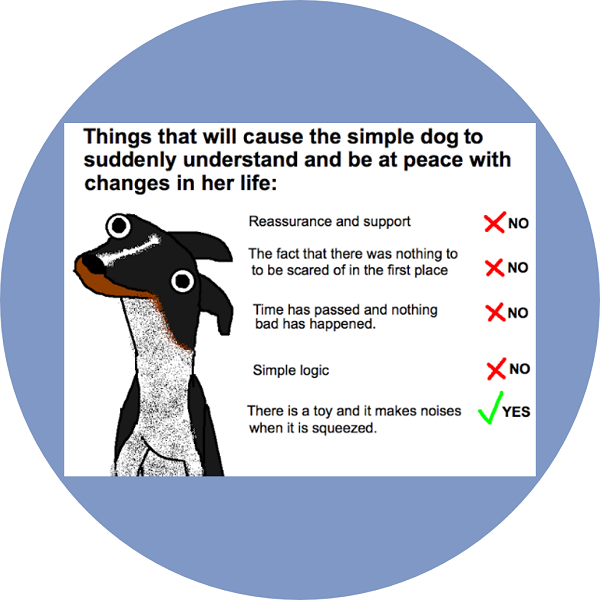
One efficient way of doing this can be to distract him with something that usually gets his attention and focus.
Doing a training session, playing or giving him a marrow bone, or a problem solving puzzle, may get him so focused so that he tunes out distracting noise.

This is not simply about distracting the animal so that he doesn’t perceive the stimuli, it’s about changing his emotional state, so that even though he might perceive the stimulus, he’s not as bothered by it. By asking for “happy” behaviours, we’re topping up the optimism bank, to use a term that Tom Mitchell & Lauren Langman from Absolute Dogs discuss here.
Also, problem solving has been shown to reduce fear – perhaps because the animal learns to control certain aspects of the environment.
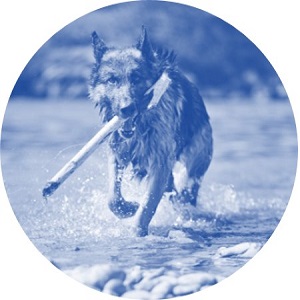
In a study on German shepherds, it was found that dogs that had a lifestyle involving a lot of play were generally less stressed than dogs who played less – play is very beneficial also outside the noise-phobia context! (Roth et al., 2016)
One alternative approach may be to ask your dog to “speak” if he knows a bark cue, as discussed in this post by Lee Charles Kelley.
Owner behaviour:
It may be difficult to remain calm if you’re concerned about your animal, but remember that your demeanor will influence your dog.
Stay calm.
The owner’s frame of mind is very influential to dogs, and it’s been shown that anxious dog owners are more prone to have dogs that develop noise phobia.
Whoever is engaging in the dog should appear content and calm rather than nervous – using a jolly voice could be risky as the dog may confuse that with fear. Beware of consoling the animal by using a sad voice as this may make things worse.

Punishment: admonitions, painful stimuli such as ear twists, or even a harsh tone of voice may increase fear, especially if the animal is sensitized.
Throw the dog a favourite treat immediately after each thunder clap or fireworks noise – or indeed after any noise! – he then learns to associate the sounds to something he really likes. Big noises lead to food. Small noises lead to food. High-pitched noises lead to food. Low-pitched noises lead to food. You get the idea. This means that during a thunderstorm or a week of intense fireworks, you should always be carrying food.
“During and after the treat tossing, visualize your most pleasant memory/fantasy in great detail. It can be rated G, like thinking about world peace or the taste of chocolate on your tongue, but it doesn’t have to be.” (Grisha Stewart, author of BAT 2.0.)
The technique is illustrated in the video below. Though the environment is full of distractions and a ton of other noises, each gun shot is followed by “yes!” and a treat. Though the dog is somewhat uncomfortable in this situation, the focus is on the owner and he eagerly takes each treat. The alternative could have been much worse.
If your dog doesn’t take the food, stop feeding and see if you can block out more of the noise / lights / static – perhaps try the bathroom? Running the shower may block out some sounds, too. Metal pipes typically supply the sink so they’re potentially a grounding device – many dogs press against the pipes, perhaps to reduce static electricity. Eileen Anderson warns against taking refuge in a bathroom with metal pipes during thunderstorms due to the small but significant risk of lightning strikes.
Should you pet a frightened dog? Be cautious of petting a frightened dog during a noisy event (especially fireworks). It may make both of you feel better, but pay attention to the animal. Stop if you see that petting makes things worse (which could occur through three different mechanisms).
Pheromones and smells:
Adaptil (previously called DAP) is a synthetic version of scents emitted by mother dogs to comfort their pups, and may be worn as collars or used as diffusers or sprays. Adaptil-collar-wearing dogs scored only half the anxiety that controls did during thunder claps in one study (Landsberg et al., 2015). Some of these collars retain their effect for up to three months (Nicolas et al., 2022).
Studies indicate that some smells have relaxing and anxiolytic effects, such as the diffusion of diluted essential oils of lavender or chamomile.
In a study of travel-induced excitement, dogs vocalized and moved less and rested more when exposed to an ambient odor of lavender than if there were no added smells.
In a shelter environment, lavender and chamomile resulted in much the same observation; in contrast, rosemary and peppermint produced the opposite effect (Graham et al., 2005).

Pressure:
Watch how your dog responds to petting during the actual noise- be careful as petting might either improve things or make it worse: if in doubt, don’t pet the animal! One option is putting gentle continuous pressure on the animal with your arm, or even leaning against the dog until you feel him relax and exhale.
This is obviously not a good idea if the animal gets even more frantic.
There are several close-fitting garments that can be used to provide calming deep pressure (Grandin, 1992): Thundershirt was found to reduce heart rate in dogs suffering from separation anxiety in a recent study, and the manufacturers boast that it works in 80% of dogs.
It’s important to put it on tightly, according to specifications – if worn loosely, Thundershirt hardly makes a difference. (King et al., 2014)
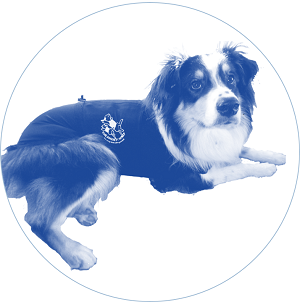
The Anxiety wrap covers more of the chest and shoulders in larger dogs than the Thundershirt and was found to reduce thunder anxiety score by 47% in dogs, helping 90% of dogs.
The Storm Defender is a cape that doesn’t apply pressure but has metallic lining that allegedly protects the wearer from static electricity during thunderstorms.
It’s a bit unclear at present whether the documented effect of the storm defender cape is due to placebo or not: in the only scientific study carried out to date, the sole method of collecting data was by owner ratings, which vastly increases the risk of placebo confounds. After 4 thunderstorms the dogs wearing the storm defender had reduced their median anxiety score by 63%, and the placebo group by 36%. Though this difference seems large, it was statistically insignificant. (Cottam & Dodman, 2009)
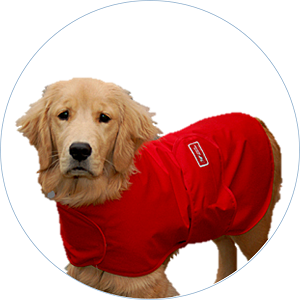
Nerdy comment: Since the sample sizes were small and there was much variability, I suspect that the statistical power of the study (the likelihood of finding a true difference) was small. Repeating the study with a larger sample and adding objective behavioural observation would perhaps shed more light on the usefulness of this device.
If you don’t have a handy pressure wrap, make one yourself.
“Please note-this wrap is only to be left on an animal for up to about 15 minutes at a time for a dog, and only up to a minute or two for a cat, and NEVER should be left on an animal unsupervised. A 2″ ace bandage is good for a small dog, and a 3″ bandage is good for a bigger dog. This is a demo of a TTouch wrap, one of the TTouch tools which is extremely useful especially for frightened or shy animals. It is also good to give general body awareness for animals who may have limited body awareness in some parts of their body.” (Sarah Houser)
A recent Case Series of 23 dogs explored using acupuncture combined with conventional effective treatments (SD/CC and alprazolam, discussed below) and found it helped 77% of the dogs over a 4-month period – an estimated improvement of about 50% compared to conventional treatment. As the authors state, future randomized controlled studies are needed to validate these preliminary findings (McDowell & Shiau, 2022).
Exercise and massage:
If possible, take a long walk with your dog before the event to drain some energy. Also, exercise leads to higher levels of serotonin in the brain, which decreases anxiety and improves coping with stress (Chaouloff, 1989).
Make sure that the dog can relieve himself as late as you dare before the event. If it’s already started, don’t inadvertently – or intentionally! – bring your dog outside into a thunderstorm or firework event. Keep him on a leash for this final outing, just to be safe. Ideally, he should know how to respond to a toileting cue.
If you’re familiar with Tellington TTouch, it may be a good idea to practice it. If you’re not familiar with it, don’t fret. Body contact releases feel-good-chemicals such as oxytocin and could calm both the dog and the owner.
However, be careful with petting during the actual noise if the dog is very stressed, as this may inadvertently make things worse: if you’re unsure it is recommended that petting is either done before the noise starts to relax the dog, or if the dog isn’t showing any signs of fear (including freezing, panting or being hyper-vigilant).
Diet and medication (available without veterinary consultation):
Certain types of diets contain tryptophan, which is a precursor to serotonin in the brain and may have a calming effect on anxious dogs. The Calm Canine diet has been found to reduce anxiety-related behaviour in dogs and increase their ability to cope with stress. (Kato et al., 2012)
In a randomized, placebo-controlled, double-blind study of 52 dogs, the nutraceutical CALMEX® was shown to reduce stress-related responses to thunderstorms and fireworks with almost 60%. CALMEX® contains 2 amino acids, a plant extract and numerous B-vitamins and takes effect within 30-60 minutes. (Eaton et al., 2021)
Adaptil tablets have been shown to reduce fireworks’ fear scores in dogs by 50% over a 7-day period – they take effect in two hours. (Giussani et al., 2014)
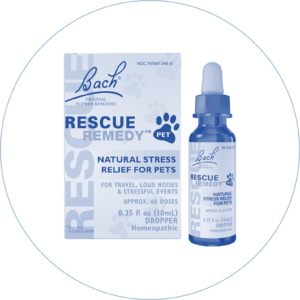
The Bach Rescue Remedy is a herbal tincture applied to the ears or added to the drinking water. Studies in people have shown that people with certain temperaments may be relieved of anxiety by the human version of this remedy (Yang, 2012).
In dogs, it is reported to take effect within an hour of administration – but no scientific study has been done, apparently.
Non-psychoactive cannabinoids (CBD) may reduce anxiety in low doses, and there are dog bisquits containing these substances, such as Treatibles or Canna-pet. The manufacturers of Treatibles claim that they take effect within five minutes to an hour, and 83% of dog owners claim Canna-pet helps with anxiety (but keep reading to see the outcome of scientific studies related to noise in particular).
However, in the veterinary community there is a concern about the disconnect between scientific evidence and public opinion and perception on the topic of cannabinoid pet treats, and the risk of impure products containing THC, the psychoactive ingredient in cannabis, which is toxic to dogs. The essential challenge is that the effects are observational and uncontrolled, and steeped in optimism by enthusiastic pet owners – and recent evidence suggests that there may be “disturbing changes in a key liver function enzyme” among other effects (Prinold, 2019). So, caution and veterinary consultation is warranted while we find out more on this topic. Indeed, a 2020 blinded study found no support for any fear-reducing effect of cannabidiol (CBD) on noise phobia in dogs. (Morris et al., 2020)
Melatonin is another fast-acting choice but that should be used with vet consultations – for one, it might interfere with female dog’s reproductive cycles.
These steps comprise the acute interventions that may be implemented only hours before a thunderstorm or fireworks.
Many of these tips are included in Susan Garrett’s short film, below – you can see them in action! Note that she says to try a combination of different approaches, but don’t overwhelm your dog by trying them all out at once – let the dog’s behaviour guide you!
If your dog panics when exposed to sharp noises, he is suffering badly and being exposed to neurocytotoxic damage, so he will thank you for taking steps to intervene.
Part 2 – planning / training stages
Animal perception differs from ours, so it could be that our poor pooches have a completely different experience than we do. For instance, they may sense the electrical discharges in the air during thunderstorms, changes in barometric pressure or smells associated with fireworks.
For this reason, it’s difficult to address some of the issues that animals may have with thunder/fireworks, and treatment success is not guaranteed. It is most difficult to help animals that have had established fears for years and if those fears have generalized to multiple situations.
So, work preemptively and assume that things will get worse, because they likely will – unless countermeasures are taken.
Off-season – don’t waste it!
Maybe you’re not reading this post in the early morning of New Year’s Eve, Independence Day or Guy Fawke’s Day? Maybe there’s no fireworks or thunderstorm forecasted for the next couple of months?
Lucky you! In that case, you actually have time to prepare and train your pet.
And here is where things get difficult. Despite the best intentions, people tend not to follow through when embarking on teaching the animal what she needs to know to stay calm during the next storm.
What to do?
First off, check with your vet that the noise-sensitivity problem isn’t pain-related or caused by other medical issues, such as gastrointestinal problems or cognitive dysfunction – they’ve all shown to be associated with noise aversion in dogs (Fagundes et al., 2018).
Then it’s time for some training.
Tell your friends what you’re planning – that gives accountability!
Tell me – and the other readers of this blog!
The power of placebo
You may have wondered why I include a whole list of scholarly references.
Or maybe not, it’s at the end and we’re only half way there… Well, most of them are included as links too. 😉
There’s two reasons, actually.
One, I’m showing you that my recommendations are backed up by solid, placebo-controlled data – or when such are lacking I try to be transparent. For most people, that increases the credibility of the recommendation.
Two, I’m trying to induce the confidence involved in the placebo effect. In other words, by making my recommendations more credible, you will have a firmer belief in them. This, in turn, will influence your behaviour. You’ll strap on the Anxiety wrap fully convinced that it will work.
It might. After all, it does in most dogs.
But importantly: you will think that it will do wonders. And so, you will act differently than if you suspect it’s going to be yet another failure. You’ll likely be less nervous yourself – and guess who will pick up on THAT?
In other words: the combination of a scientifically proven product and a confident owner is what has the highest chance of being successful.
This detour brings us to the next topic:
Owner behaviour (revisited)
This is the easy one, but perhaps also the most difficult. You see, despite the best intentions, people often don’t follow through to the not-so-bitter end. They give up. Efforts trickle down to nothing.
So, since this is so important, what can you do to ensure crossing the finish line?
There’s actually some research on what characterizes people that have the willpower to follow through.
- Focus on one thing. Rather than redecorating your house, losing weight and writing a novel in your spare time, focus on this one task: helping your dog overcome fear of loud noises.
- Create habits. Instead of thinking “I’m sure going to help my poor pooch”, plan to spend five minutes after every breakfast training.
- Be specific. Plan what you’ll do. Then stick to the plan.
- Go public. Tell others what you’re doing. Tell me what you’re doing! 🙂 I’ll offer encouragement, and so will others.
You get the idea. Take a moment to think about this and commit to that you’re going to be one of the people who see it through.
If your dog is fearful of loud noises, it will very likely get worse if you don’t act, as only 4% recover without intervention.
Also, be prepared that you might not feel all that successful. Most animals improve with training, so they’ll hide rather than run amok, but many won’t be all that happy.
You might have to still rely on a stock of sedatives to help your dog through the noisy events, and continue using many of the tips on this post.
Remember that if you do nothing, things will get worse.
With training, expect most improvement to occur within one month.
Learning
The training that you’ll be doing involves learning for the dog. Think of it as re-wiring your dog’s brain. You want loud noises to become neutral or even nice.
Systematic Desensitization (SD) involves exposing the animal to the fearful stimulus at gradually increasing volume, playing recordings of the sound that is disturbing to your dog.
Attention to detail here can be the difference between success and failure:
- The stimulus that you use should be one that the animal fears, not any random loud noise.
- The exposure, however, should be at such a low level that you see no fear reaction (we refer to this as below threshold). The animal should initially notice the stimulus but not respond fearfully to it.
- Not only should the animal not respond, she should be relaxed.
- Play the sounds frequently rather than long durations: it’s more efficient to do 10 minutes 5 times a week than 50 minutes once.
- Don’t progress to the next level (increase the volume of the stimulus sound) until the animal ignores it at the present level.
- Vary the origin of the sound, if you have a surround sound system, use it. The scary sounds typically come from the windows, so if possible let the training sounds come from there, too.
- Combine SD with CC (learn what that is below!) to advance more quickly.
Here are some free recordings that you could use.
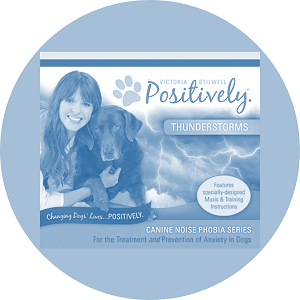
There are also commercially available recordings of thunder and fireworks. In the Canine Noise Phobia series developed in collaboration with Victoria Stilwell, those sounds are masked by psychoacoustic music that has been especially designed to be very relaxing to dogs.
Your animal is likely responding to a range of different stimuli.
Thunder is complex since it involves changes in barometer pressure, the smell of ozone, electrostatic charges, lightning and thunder, which all might be perceived and feared by the dog.
The only variables that you can reasonably try to desensitize are the last two.
However, if you do that successfully you have eliminated some triggers and reduced the trigger stacking that otherwise occurs, so expect improvement!
Counterconditioning (CC) is about re-learning associations. Rather than being frightening, we want those flashes of light and sharp noises to predict wonderful things.
Find something that is irresistible to your animal, such as some favourite treat, toy or scratching their sweet spots.
Consistently give them access to the favourite thing immediately after each exposure to the aversive stimulus. “Bang! – is that chicken liver?”
You get the idea. Beware, though, that it’s difficult to perform correctly if you haven’t tried this procedure before, and you risk scaring your dog even further. Check out this link to avoid those problems.
Combine with SD (above) for maximum effect.
I’m a fan of empowering animals, giving them more control and choices in their lives. For instance, Grisha Stewart describes how she trains her dogs to ask her for the sound, using a “More Please” signal.
In a recent study, it was shown that Conditioned Relaxation (CR) was on par with counter conditioning in reducing noise phobia (69% versus 70% of cases). Check out the procedure – right here, for instance. In short, you teach the dog to associate a word, a smell and a touch with relaxed emotional states, both through a passive and an active procedure, in the absence of fear triggers.
One study found that dogs that learned to problem solve grew less frightened in other situations (Zilocki et al., 2016). This hasn’t been tested with noise phobias but I wouldn’t be surprised if there is a correlation between lack-of-control and phobias in general…!
Putting the dog in a playful/hunting state of mind may be another approach – for instance by repeatedly playing boisterous games with a a paper bag, as suggested in this blog post.
Medication (prescriptions / long-term)
Given the difficulties in targeting some of the elements that may set off fear, medication is often part of the solution (together with behaviour modification, described above) to reduce or eliminate noise phobias. A visit to the vet is therefore part of the long-term solution.
Two types may be considered: quick-acting drugs and long-term medication.
Quick acting drugs.
There are sedatives (benzodiazepines) with amnesic properties that you give a few hours before the event.
In other words, your dog will get drowsy and not remember anything from the noisy episode. The amnesic effects will reduce the risk of regression in your training.
Side effects may be vomiting, and drugs should be given before the animal shows any signs of fear else it may have opposite effects (worsening fears). These are prescription drugs, and you should consult your vet to ensure it’s a good choice for your pet.
Acepromazine has been widely prescribed, but has dissociative effects and also increases sound sensitivity: thus, it does more harm than good and should be avoided.
Sileo is a new prescription drug (May 2016) tested specifically on dogs, that works rapidly but wears off within hours — like by the time a thunderstorm or fireworks display is over. Also, it doesn’t give any sedative side effects. It’s a gel that can be applied between the dog’s cheek and gum by the owner at the first sign of anxiety or at the first loud noise, and then reapplied at two hour intervals if necessary. Note that this product is so new it hasn’t been tested with young or breeding dogs. Sileo, or Dexmedetomidine oromucosal gel, was found to be effective or very effective in 72% of dogs (compared to 37% of dogs getting placebo).
Wear gloves at administration, as shown in this film.
Beware of the risk of overdosing Sileo – check out this warning!
Long-term mood changers.
Harmonease Chewable tablets are non-prescriptive botanical extracts that have been shown to reduce fear of thunder in 60% of dogs. (DePorter et al., 2012) – this product has lately been discontinued and replaced by Zentrol Chewable tablets, including novel ingredients.
The Quetin supplement containing tryptophan, valerian and passiflora, was shown to reduce behavioural and physiological correlates of fear associated with New Year’s eve fireworks with up to a 41% improvement in this randomized, double-blinded and placebo-controlled study.
Another nutritional supplement, Anxitane, containing the amino acid L-theanine, has been shown to decrease anxiety scores during thunderstorms with prolonged use. (Pike et al., 2015)
Your vet will likely give you an antidepressant, such as an SSRI or TCA.
There are a large number of different approaches to dealing with noise phobia – find the one that works for you!
Be observant of what works for your dog. Keep a log of what strategies you’ve tried and the extent to which it worked! That’s especially helpful if you’re consulting with a veterinarian or behaviour consultant – it will help them determine the best plan for action.
You’ll likely need to use a combination of long term-mood changers, quick acting sedatives, SD/CC and arrangement of the environment to handle the most difficult cases.
Part 3: Prevention – don’t wait..!
So far, we’ve addressed the fearful dogs.
Did you just get a new puppy? Is your young dog unafraid of sudden noises, thunder or fireworks? Congratulations!
But wait, if at least 20% of dogs develop fear of noises (and that’s the lowest estimate I’ve seen), doesn’t that mean that the new adorable puppy actually might develop fear of noises after the first exposure?
Yes, that’s it.
So, if your puppy is unafraid right now – let’s keep it that way!
Prevention is the most important thing you can do for your dog.
You might think that if your dog was unaffected by noise through the first year, including hunting season, thunderstorms and fireworks, he will now be safe.
I’m sorry to be the one to break it to you, but… that’s not true, unfortunately.
More than half the fearful dogs develop fear of loud noises after celebrating their first birthday. For about 1/3 of animals, the onset is gradual.
If your adult dog suddenly develops noise phobia, have a vet look at him to rule out pain issues – pain could likely exacerbate the fear.
And to make things worse, dogs with storm or noise phobia may be more at risk of developing separation anxiety later.
There are breed differences in how susceptible dogs are to developing noise phobia – and there’s also a bigger risk for neutered dogs.
Dogs are also more fearful of thunder when their owners are fearful of it, suggesting that it’s important to work on one’s own phobias.
What to do:
- don’t flood the animal by exposing it to noise and hoping it will habituate,
- use SD/CC and conditioned relaxation, as suggested above
- when you’re expecting noise, use all the other tricks in the bag to set up for success. Don’t wait until your dog starts panting in preparing a cozy hiding place.
Here Debbie Martin illustrates how she creates positive associations with a safe place that can help the animal learn to self-soothe in a noisy environment.
One way to work preventatively is to use a noise box, here demonstrated by Julie Heyes. This process, in my mind, helps the animal build resilience through learning to overcome small challenges. Note how she avoids overwhelm and flooding by carefully observing the dog and adjusting the difficulty level, and being careful not to add more objects when the animal is in the box. We don’t want to induce conflict, we want to present an interesting challenge from which the dog can grow those resilience muscles.
Data indicates that training puppies or non-fearful adults to associate the noise with positive stimuli is highly effective in preventing later development of firework fears (Riemer, 2019).
Explaining to the animal what’s going on might also be helpful. One of my students reported that she had started saying “noise” just before using things like the coffee grinder, the vacuum cleaner or the treadmill. That makes the loud noises not only more predictable, but over time the animal also learns that when the person says “noise” (or whatever word you’re using), something noisy will happen and everything is going to be alright. My student had also incorporated elements of counterconditioning as well as a start button procedure into her training, and she sent me an enthusiastic email (this is indeed a cat, but the same principle would certainly apply for dogs):
“So tonight was the first time she really got tested when just outside my home there were loud fireworks for over two minutes. She was startled at first, walked to another room (a milder reaction than usual I must say), and as soon as I said ‘noise’ she came walking back to me with a happy tail and looking at me like she does when training saying ‘where’s my snack?’. I was prepared and had snacks within reach, so I could quickly deliver while the fireworks were still going on. She just kept giving me eye contact and wasn’t paying attention to or fearful of the loud fireworks. Such a joy to see training paying off!”
An ounce of prevention is worth a pound of cure: if you do the right thing now, fireworks or thunder could be a breeze for the puppy later.
More resources on prevention / training dogs to reduce noise phobia:
- Six ways to prepare your dog for fireworks– Eileen Andersson
- Don’t “ace” the fear. Why acepromazine may make your dog’s fireworks fear worse – Marty Becker.
- Fear, fireworks and neuroplasticity – what you should never do when your dog is afraid -Jennifer Cattet.
- The 3 P’s – does your dog need medication? – Susanne Clothier
- How to train your dog not to be scared – Zac George
- Thunder phobia and sound sensitivities – Patricia McConnell
- Summer sounds – how to help your dog through scary noises – Karen Pryor Clicker Training.
- Dealing with fireworks anxiety – Victoria Stilwell
- Preventing thunder phobia in dogs – Tonya Wilhelm
- Therapy and Prevention of Noise Fears in Dogs—A Review of the Current Evidence for Practitioners – Stephanie Riemer
Part 4: Recognizing early signs of fear.
Look out for these indicators:
- shaking,
- dilated pupils,
- ears back,
- tucked tail,
- salivating,
- panting,
- attention seeking,
- hiding,
- urinating,
- defecating, and
- running away
Many of these signs, and others, are shown in this film from the fabulous Sophia Yin. See if you can identify the signs of fear – run the clip twice, first silently, and then listen to Sophia herself commenting and pointing out these subtle fear indicators (with permission, drsophiayin.com / CattleDog Publishing)
Herding dogs and herding crossbreeds are more at risk of developing noise aversion, and females are more prone to phobias than males.
Intriguingly, there is a study showing that paw preference (an indirect measure of lateralization in the brain) correlates with noise phobia. (Branson & Rogers, 2006)
Try putting a toy stuffed with goodies in front of your dog and watch which paw he uses to interact with it. Spend about half an hour looking at this, and jot down whether he’s using the left or the right paw.
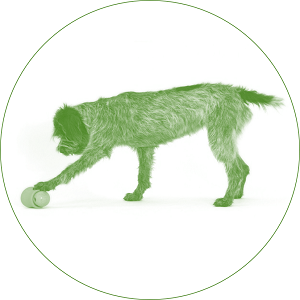
If he’s using predominantly the left or the right, noise reactivity scores should be reasonably low. If he’s alternating between paws, however, reactivity scores could be about 3 times as high as if he’s a leftie or a rightie.
According to that study, dogs without paw preferences showed about half of the symptoms above when exposed to noise: In other words, warning bells should go off if your puppy doesn’t show paw preference.
Dogs with paw preferences, on the other hand, showed on average only two of the symptoms in response to noise.
So, less risky it would seem, but I would encourage working with your animal even if it’s not in any of these risk groups, just to be safe.
For most dogs, noise aversion occurs in one-trial learning.
For some, it develops gradually, so that’s why I suggest you don’t ignore if your dog is only showing a few of the behaviours listed above.
Also, if your dog develops noise aversion (and actually up to 50% of dog owners say their dogs are “scared of some noises”), there is an increased risk of developing separation anxiety. (Sherman & Mills, 2008)
There’s simply less time, effort and suffering involved in prevention than trying to fix things once your dog has developed noise phobia and it has generalized into separation anxiety…
Prevention is key. Learn to recognize the early signs of fear in your dog, and you should be able to live through the next thunderstorm or fireworks!
I hope you find this information useful. Perhaps you know someone else whose dog would be helped by this info?
If so, please share this blog post.
Did I forget anything, or should I update the info? Do you disagree with any of these recommendations? Which has worked best for you? Please let us know in the comment’s section!
***

References.
Branson & Rogers (2006). Relationship between paw preference strength and noise phobia in Canis familiaris.
Cottam & Dodman (2009). “Comparison of the effectiveness of a purported anti-static cape (the Storm Defender®) vs. a placebo cape in the treatment of canine thunderstorm phobia as assessed by owners’ reports.”
Cottam et al. (2013). The effectiveness of the Anxiety Wrap in the treatment of canine thunderstorm phobia: An open-label trial.
Crowell-Davis (2008). Desensitization and Counterconditioning: The Details of Success.
Crowell-Davis et al. (2003). Use of clomipramine, alprazolam, and behavior modification for treatment of storm phobia in dogs.
Curtis (2013). On Your Best Behavior: Noise & Storm Phobias in Dogs
DePorter et al. (2012). Harmonease Chewable Tablets reduces noise-induced fear and anxiety in a laboratory canine thunderstorm simulation: A blinded and placebo-controlled study.
Eaton et al., (2021). A randomised, double-blind, placebo-controlled trial, assessing the effect of a nutraceutical tablet in the management of stress in pet dogs.
Giussani et al. (2014). Evaluation of the efficacy of Adaptil® tablets versus placebo in the management of firework fears in dogs.
Graham et al. (2005). The influence of olfactory stimulation on the behaviour of dogs housed in a rescue shelter.
Kato et al., (2012). Effects of prescription diet on dealing with stressful situations and performance of anxiety-related behaviors in privately owned anxious dogs.
King et al., (2014). The effect of a pressure wrap (ThunderShirt®) on heart rate and behavior in canines diagnosed with anxiety disorder.
Korpivaara et al., (2017). Dexmedetomidine oromucosal gel for noise-associated acute anxiety and fear in dogs—a randomised, double-blind, placebo-controlled clinical study.
Landsberg et al., (2015). Dog-appeasing pheromone collars reduce sound-induced fear and anxiety in beagle dogs: a placebo-controlled study.
Leeds & Wagner (2009). Through a Dog’s Ear: Using Sound to Improve the Health and Behavior of Your Canine Companion.
Mayberg et al. (2014). The functional neuroanatomy of the placebo effect.
McCobb et al. (2001). Thunderstorm phobia in dogs: an internet survey of 69 cases.
McDowell & Shiau. (2022). Effectiveness of Integrated Medical Treatment for Thunderstorm Aversion: A Case Series of 23 Dogs.
Morris et al. (2020). The Impact of Feeding Cannabidiol (CBD) Containing Treats on Canine Response to a Noise-Induced Fear Response Test
Nicolas et al. (2022). Owner-Perception of the Effects of Two Long-Lasting Dog-Appeasing Pheromone Analog Devices on Situational Stress in Dogs.
Okamoto et al. (2024). Factors influencing the development of canine fear of thunder.
Pike et al. (2015). An open label prospective study of the use of L-theanine (Anxitane®) in storm sensitive client owned dogs.
Ramos et al. (2024). Is It Possible to Mitigate Fear of Fireworks in Dogs? A Study on the Behavioural and Physiological Effects of a Psychoactive Supplement.
Riemer. (2019) Effectiveness of treatments for firework fears in dogs.
Roth et al. (2016). Hair cortisol varies with season and lifestyle and relates to human interactions in German shepherd dogs.
Sherman & Mills (2008). Canine anxieties and phobias: an update on separation anxiety and noise aversions.
Storengen & Lingaas (2015). Noise sensitivity in 17 dog breeds: Prevalence, breed risk and correlation with fear in other situations.
van Herwijnen et al., 2024. Firework aversion in cats and dogs as reported by Dutch animal owners.
Yang (2012). Effects of Bach Rescue Remedy on Women of Various Personality Traits Evaluated by Heart Rate Variability.
Zilocch et al. (2013). Problem solving games as a tool to reduce fear in dogs: preliminary results.
Disclaimer: While every caution has been taken to provide my readers with the most accurate information and honest analysis, please use your discretion before taking any decisions based on the information in this blog. I will rejoice with you when you’re successful, and offer my sincerest condolences if you’re not. I will not, however, compensate you in any way whatsoever if you ever happen to suffer a loss/inconvenience/damage because of/while making use of information in this blog.
Disclosure: I’m not getting affiliate commissions for any products you’d happen to buy after clicking links from this blog.

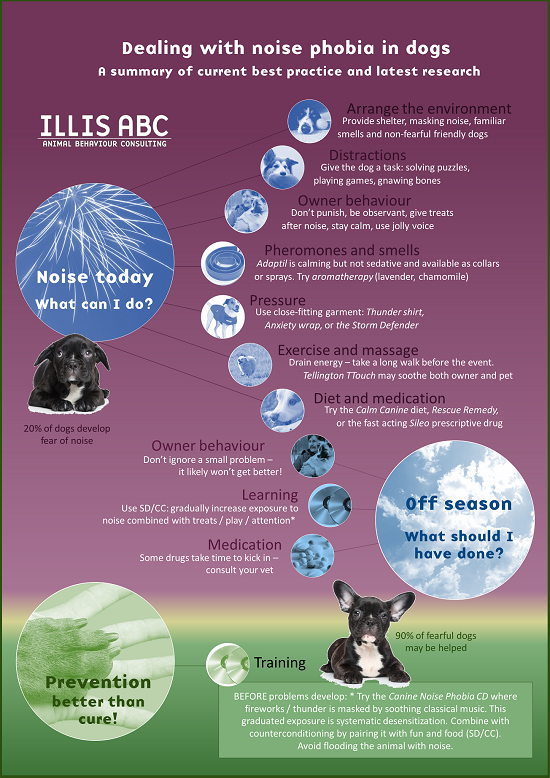
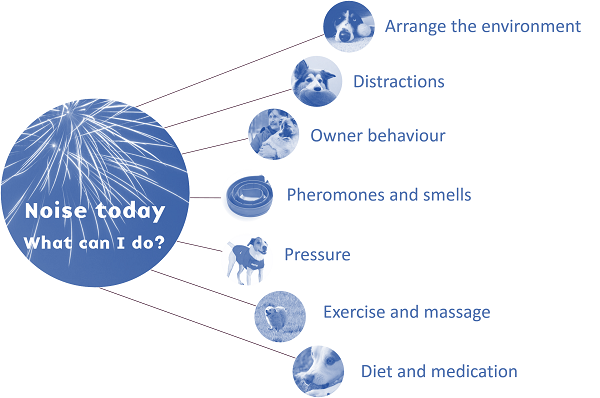
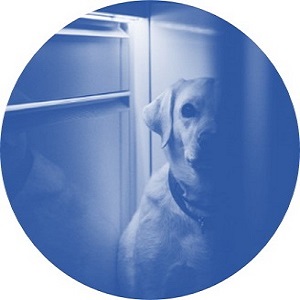
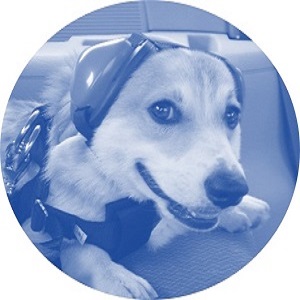
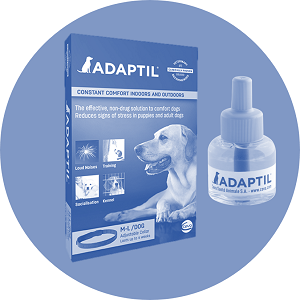
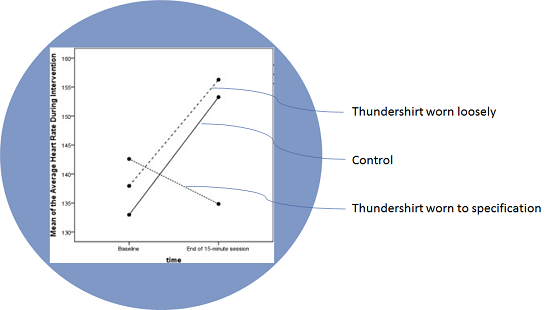
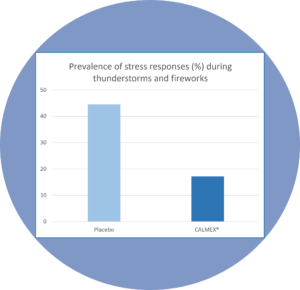
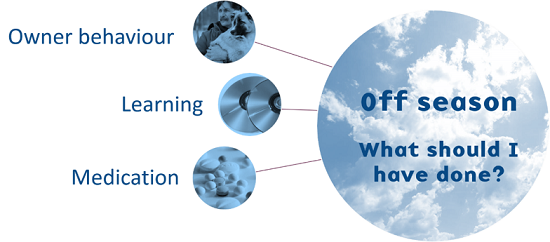

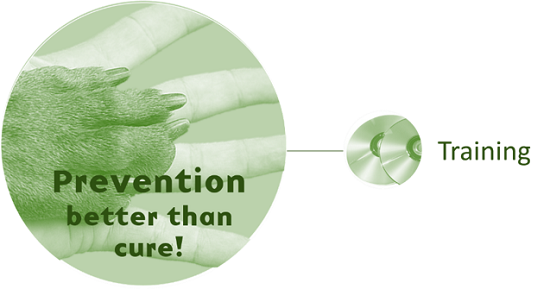
48 replies on “Dogs and fireworks (30+ proven techniques to eliminate noise phobia)”
Thanks so much for all this. I was interested in the condition relaxation, but the link you provided only takes us to a blog post mentioning what a great technique it is, but not reflecting the technique.
oh, thanks for letting me know, Candace! here’s a good interview – and a link to a useful protocol too – https://pawsandreward.com/episode34/
Another common, yet often missed, stress signal (aka indication of fear in this context) in dogs is “paw lifting”: lifting one paw off the ground while sitting.
Yes – so true, great catch! 🙂
Fantastic article! Thank you for listing methods that have a scientific basis and for providing references. This makes your blog unique – it’s one of the best and most comprehensive articles I have read about sound phobias in dogs. It is a pity that so little is known about sound phobias in cats. I hope that over the years their problems will see more scientific publications.
Thanks Jagna – so glad you enjoyed it! 🙂 And yes, I’m assuming that many animal species are distressed by thunder / fireworks..!
Very useful, thank you.
You’re welcome, Suzy!
Thank you for the great tips, advice and information on how to keep a dog calm when they hear fireworks and other loud noises. I learned a lot and I will definitely use your suggestions in the future with my dog. Excellent article.
Thanks! So glad to hear that you found it useful! 🙂
This is the most informative blog I’ve found to date in my search for help with firework noise. One question re applying pressure, I’ve recently purchased a dog hood, it’s a bit like a snood or a sock that goes over the dogs head and covers her ears. It helped calm her during fireworks last night and she seems happy having it on, but I’m wondering are there any negatives to using pressure like this around the ears?
Appreciate any advice
So glad to hear you found this post useful! Unfortunately, I’m a theoretical-type person, so I don’t work with dogs hands-on. 🙂 I’d monitor the use of it, and not let her wear it for too long. And work on some of the other tips listed too, if for some reason you have to stop using it. Always good to have a backup plan! 🙂
Thank you
We have a Great Dane with severe noise phobia. We’ve tried everything you mentioned above, except cannabis treats (which we might try if we can find them). Nothing works. She prefers to hide in our ground floor bathroom, but Every clap or boom sends her into a frenzy, She gets up from wherever she is seated and looks for something to dig at: shower door, trash can, us! Her favorite spot is to try and dig herself in behind the toilet. You mentioned something about pipes and static that I hadn’t read anywhere before, so that clears up the mystery of why she migrates there. The problem is we cannot just let her do it because she has previously pulled the pipe from the wall & flooded the bathroom while we were away. (We no longer leave her alone during storms.) The desensitizing program is useless because she has absolutely no reaction to the “fake” thunder or fireworks, no matter what volume we play them. Its like she knows they are fake and therefore nothing to be afraid of. We’ve tried thunder shirts, blindfolds, earmuffs…none seem to make a difference. Running the bathroom fan helps drown out some noise, but now it seems to get her even more worked up when we turn it on, likely because she associates it with her phobia. Sileo produced a tiny reduction in the severity of her reaction, but not enough to justify the cost. We’ve tried to create a safe space for her in a small dugout area under the stairs, but she doesn’t stay put because, as I mentioned before, she moves & digs at EVERY boom or clap. The only thing that works is to drug her with Xanax about 30 min before it starts. She’ll still react to the initial sounds, but about 20-30 min into the event, she usually conks out. Then she is dopey and shaky on her feet for hours afterward & we hate seeing her like that. We only resort to the meds when we are going to have a prolonged storm event. Otherwise we just “deal” with her craziness by trying to distract her, sopping up her drool puddles, singing or watching loud sitcoms & keeping her away from the pipes!
I’d love to know if you have any additional thoughts or suggestions!!!
So sorry to hear about your struggles! I put everything I know into the blog post, so don’t have any further suggestions, unfortunately – I didn’t hold anything back..! I would consult with a veterinary behaviourist to see if they might help. Best of luck!
I’ve seen the spectrum of noise reactions – from a retriever started in hunting as a pup who grew up to enjoy thunderstorms and fireworks because she likely thought it meant she could go hunting. Another retriever was not trained but insensitive as a pup. About 8 years old she started getting weird in pending-storm weather. Because this normally calm and happy dog became irritable sometimes for a long while in winter storms, I started checking a website for the location of lightning strikes after I would notice her irritability. I found that she was sensitive to strikes 60 miles away that I had no direct perception of. So I thanked her for the warning, gave her treats. Eventually the storm came to use, and she was OK with that.
it’s humbling to realize just how little we humans perceive of the world around us… smells, sounds… what else are we missing!?
Thanks for the important information. It can be devastating to affected dogs.
Here’s another good resource.
Dog Nerds, the online dog behavior solutions company, has a course to change noise aversion. It can be found at dognerds.thinkific.com.
great – thanks for sharing! 🙂
Another good resource for sound effects for desensitisation and others : https://www.dogstrust.org.uk/help-advice/dog-behaviour-health/sound-therapy-for-pets
thanks for sharing! 🙂
[…] This blog by ILLIS Animal Behavior Consulting provides many more suggests and cites a very comprehensive list of scientific studies. […]
I learned a lot form the advice and insights. However the promotion of the Royal Canin diet (not species appropriate) and the drugs with warnings and potential serious side effects one NOT tested on dogs is frightening to me. Homeopathy and other safer natural products are healthier choices. Thank you for the information. I think I can deploy some of the strategies and techniques and that I’m looking forward to.
Great that you found some insights that you might find useful!
There is at present no scientific evidence that homeopathic remedies have effects beyond placebo, which is why I don’t list those in this list. Also, I might add that I’m not promoting anything here (that is, I don’t get paid), I’m simply putting together the available information.
I like that you lift the issue of side effects though, it’s important to take into account and consider whether such treatments are the lesser of two evils (those listed in this blog post has had documented effect beyond placebo on noise phobia in dogs, after all).
[…] For dogs who are noise sensitive, summertime can be a very difficult season for them. Thunderstorms, fireworks, neighbors shooting off guns… it’s just one thing after another! Did you know that only 14% of pets who disappear over the 4th of July holiday make it home again? Terrifying! Whether your dog is scared of noises or not, I suggest you check out the blog by Karolina Westlund – I’ll link it below! In this blog post, you’ll learn: 1) how to help your anxious dog on the same day of the fireworks or thunderstorm, 2) how to prepare your poor pooch when there’s more time, 3) how to prevent your puppy from developing fear of noise, and 4) how to recognize the early signs of anxiety. 9 Ways to Decrease Noise Phobia in Dogs […]
Hej Karolia Fremragende artikel om hunde & fyrværkeri. For 1-2 år siden skrev jeg om samme emne, det kan have din interesse 🙂 Og tak for et fremragende oplæg på Askov Højskole venlig hilsen Per i Odense, DK. http://www.hundefamilien.dk/206118776
Trevligt, tack! 🙂
Thank you for this wealth of information. My 2 1/2 yo rescue has fear aggression and noise phobia that developed at 1 year. We are working with a behaviorist and a trainer to help my pup, and we just experienced 4th of July. This year I treated her with rotisserie chicken with each bang. She did learn to come to me for treats when a loud noise occurred. Unfortunately, all that treating also made her sick the next day (she has recovered). She is on Fluoxetine and Trazodone on a regular basis, and I’m afraid to medicate her even further during these events.
Glad to hear that the 4th went reasonably OK, even though she got sick from all the treats…! Perhaps for next time you can try dividing the treats into even smaller pieces so that even if you give her a large amount the total sum still isn’t larger than an average daily consumption for her. Good luck!
An excellent article Karolina and shared. Thank you.
Glad you liked it – hope it helps! 🙂
4th of July is coming. I have been working 2 months with my BC who is terrified of thunder ,gun shots and fireworks. I totally agree with your theory of lack of control might cause more phobia considering he was tied outside the first 15 months of his life.
I read your blog last year and implemented my calming attitude and letting him go and hide wherever he wanted. Thunder shirt helped a little.
This year I employed a TTouch person who has shown him how to ground the energy into the ground. That seems to give a better recovery ….normally he is exhausted for a day afterwards. He seems to not hold on to the event.
Lastly, I am giving him cannabis dog biscuits which has really ,really helped him not get so over the top when he senses a storm coming.
Thank you for posting these suggestions again. I am hoping he will be much better this year.
Linda, thanks for the update – great that you’re keeping track of what seems to work and what doesn’t.
Thanks for the tip about cannabinoids – fascinating. I found some interesting links so I’m adding a section to this in the blog post. Thanks!
You’re incredible! Very detail post:) Thank you very much for sharing this!
Wonderful! Thank you for the list! Romy is doing much better than compared to a few years ago since we have been training with CC, but I think she will love the squeaky toys and Adaptil tonight. Thanks!
great to hear you’ve made progress – hope it went even better this time..!
[…] P.S. Today is the Fourth of July, which I tend to think is probably the least favorite holiday of most American dogs. Or at least the 20% of them with severe noise phobias, anyway. For those looking, I really like this helpful guide: http://illis.se/en/nine-ways-to-reduce-firework-and-thunder-phobia-in-dogs/ […]
[…] Teaching your dog to stop barking at the door and jumping at visitors. How to deal with the cat scratching your favorite couch. Overcoming and preventing fear of fireworks or thunder… […]
Hello mates, nice piece of writing and good urging commented here, I am truly enjoying by these.
I was suggested this web site by my cousin. I’m not
sure whether this post is written by him as nobody else know such detailed about
my trouble. You’re incredible! Thanks!
thanks for the feedback, I’m glad you found my posts useful – and that they help you and your dog..! 🙂 //Karolina
Awesome article.
thanks! 🙂 //Karolina
I would like more information on dealing with a fearful dog. Sadie is a 3 year old Ridgeback. She gets so scared with fireeorks and storms. She did well in puppy class but we had a bad Guy Fawkes when she was about a year and it has remained. She also doesn’t like men, some a lot more than others!
Dear Winsome, sorry to hear about Sadie. During “low season”, see if you can find the time to do some proper training for about 4 weeks, playing those annoying sounds at such low levels that she’s not bothered by them. At the same time, after each noise make sure she gets some fantastic treats. This way she will learn that a) the noise isn’t all that bad after all, and b) it’s followed by fabulous treats so it’s actually something you can look forward to. Strange as it may sound, you can use the same technique with men. See a man in the distance, get a treat. You can even have the guys throwing the treats to her. Make sure they’re not too close or she might sensitize. Check out my other blog posts on fear, and sign up for the free e-course on how to handle fear, you’ll find plenty more ideas there. There’s several ways to approach it and it may take some time for you to find out what works best for you and Sadie. Good luck! //Karolina
Look into Natural Dog Training by Kevin Behan. Problem solving and working his 5 Core Exercises does put dogs more in control of their environment thereby decreasing fear, anxiety, and aggression.
Thanks for the tip! Control really boosts confidence – even in other situations than where it was trained! 🙂
[…] here’s 9 more tips on how to reduce fear of noise in dogs during the acute phase, the off-season phase, as well as the preventive phase. Want all the […]